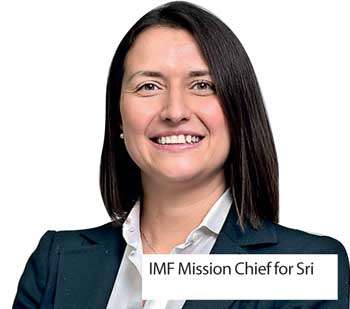23 Apr 2018 - {{hitsCtrl.values.hits}}

The government appears to be confronted with the difficult choice between appeasing the International Monetary Fund (IMF) and its electorate, as the IMF has issued an ultimatum to the government to bring an automatic fuel pricing formula before June or they may hold the fourth review of their US $ 1.5 billion stabilisation programme with Sri Lanka.
Sri Lanka failed to meet a March deadline by the IMF to put in place a cost-reflective pricing formula for fuel with the current coalition government receiving an embarrassing election drubbing at the local government polls held in February.
IMF Mission Chief for Sri Lanka, Manuela Goretti last week said the Executive Board of the IMF would only “consider” the completion of the fourth programme review in June, provided the Cabinet approves an automatic fuel pricing mechanism.
“Subject to Cabinet approval of an automatic fuel pricing mechanism—consistent with the EFF-supported programme, the Board is expected to consider Sri Lanka’s request for the completion of the fourth review in June 2018”, Goretti said last Friday, after reaching a staff-level agreement following the discussions with the authorities in Colombo during the Spring Meetings in Washington DC.
The tough stance from the IMF comes amid the remarks from the minister in-charge of petroleum resources development that any final decision on a pricing formula lies in the hands of the President and the Prime Minister. This assertion by Minister Arjuna Ranatunga is a clear reflection of how politicised fuel pricing has become in Sri Lanka in manipulating the electorate. In repose to increasing global fuel prices, Lanka IOC, Sri Lanka’s only privately-owned fuel distributor, increased their prices few weeks ago. This move has led to higher losses at Ceylon Petroleum Corporation (CPC) as an increased number of drivers started pumping fuel at CPC fuel outlets due to lower prices.
Automatic pricing formulae for fuel and electricity were long overdue in Sri Lanka as continued losses at the two state utilities have undermined the country’s fiscal consolidation and diverted resources from productive developmental needs.
While an automatic pricing formula will raise inflation in the US $ 87 billion economy in the short-term, economists opine that price pressures will gradually subside over the medium-term when public funds are no longer needed to run public utility providers such as the CPC and Ceylon Electricity Board— the two biggest loss-making, State-owned enterprises. It was only last week Mirror Business exclusive reported quoting the Asian Development Bank that Cabinet nod for an automatic fuel pricing formula is likely before the end of 2018 as the government is unable to absorb mounting losses and resulting public debt amid fiscal consolidation targets and bunched up external debt repayments from next year.
Publicly guaranteed debt including State-owned Enterprise (SoE) debt is estimated to the equivalent of 4.2 percent of GDP. Additional SoE financial obligations were estimated to be equal to 11.9 percent of GDP at the end of 2016.
Despite Sri Lanka raising US $ 2.5 billion in a sovereign bond issue marking its largest ever off-shore bond offering, debt rolling over capacity largely hinges on global market interest rates and domestic fiscal stability, which determine the investor confidence on the Sri Lankan economy.
After the country faced a self-inflicted balance of payment crisis, Sri Lanka entered in to a 3-year US $ 1.5 billion extended fund facility with the IMF in June 2016 on the conditions spanning from fiscal consolidation, inflation targeting, reserve building and a host of structural reforms to its loss-making state utilities.
18 Nov 2024 2 hours ago
18 Nov 2024 3 hours ago
18 Nov 2024 3 hours ago
18 Nov 2024 4 hours ago
18 Nov 2024 8 hours ago